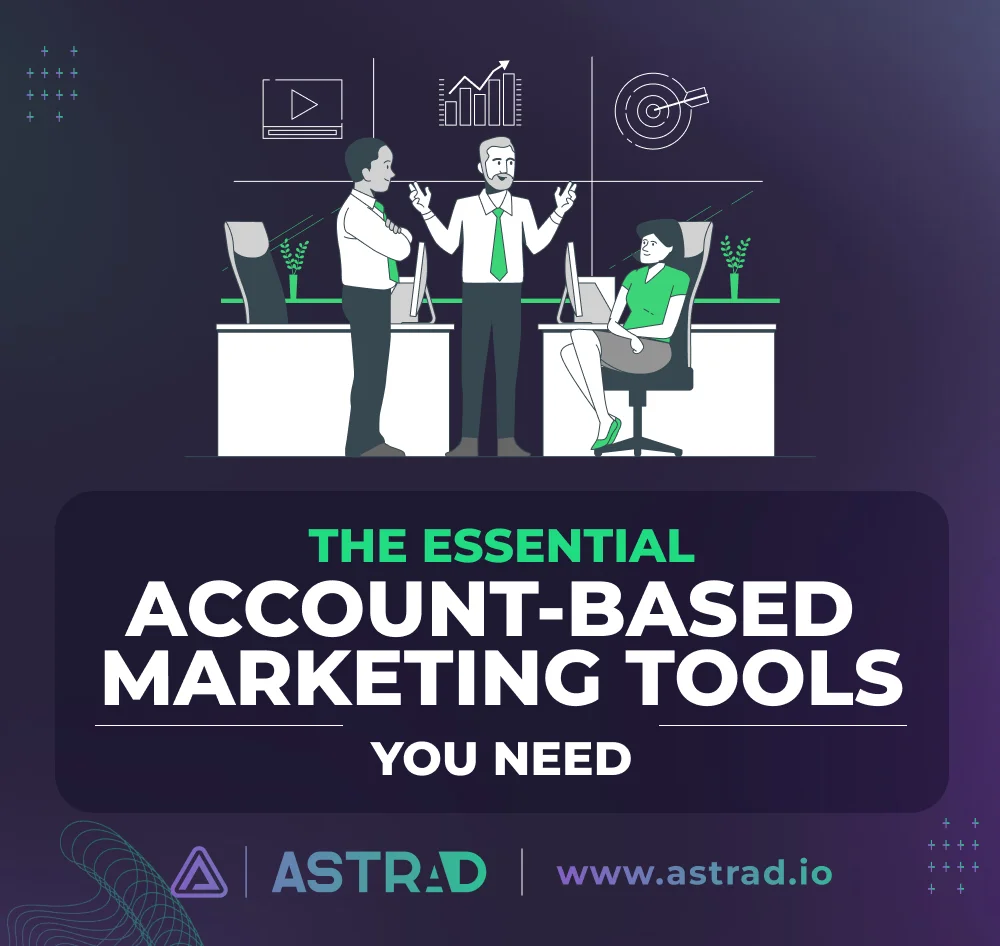The revolution is here, and part of it is fueled by Account-Based Marketing (ABM) tools. They are the cat’s meow when it comes to top-of-the-line marketing tools used right now. This guide will help you unlock essential platforms for crafting personalized experiences, boosting engagement, and achieving your required marketing goals. Choosing the right fit gases up your success — you’ll be cooking with fire in no time. Let’s dive in and discover the ABM tools you’ll need to propel your business to new heights.
What is Account-Based Marketing - ABM?
Account-based marketing – ABM – has revolutionized traditional B2B marketing. Instead of casting a broad net, it focuses on identifying and engaging select high-value accounts. Imagine treating each key account like its own unique market and crafting personalized campaigns that resonate with their specific needs and challenges. This strategic approach fosters deeper relationships, accelerates sales cycles, and delivers a higher return on investment. In today’s competitive B2B climate, ABM isn’t just an option; it is a powerful mindset for building stronger and more profitable customer relationships.
Choosing the right selection of ABM tools is like choosing the right napalm for your rocket boosters — for your marketing strategy. They are essential for amplifying your account-based marketing efforts and driving significant business outcomes.
These tools enable you to:
Identify and Segment Ideal Accounts
Leverage data and analytics to pinpoint the most valuable targets and tailor messages to their needs and pain points.
Orchestrate Multichannel Campaigns
Seamlessly integrate email, social media, advertising, and direct mail for a cohesive and impactful experience.
Measure and Optimize Performance
Track key metrics like engagement, website visits, and pipeline progression to continuously refine your approach.
What are ABM Tools?
ABM tools are a suite of software platforms and solutions that enable businesses to implement and manage their account-based marketing strategies. They provide features and functionalities that address the specific challenges of tailoring marketing efforts to focus on high-value target accounts. By utilizing and incorporating ABM tools into their marketing supply line, businesses can streamline their efforts and engage and nurture relationships with key accounts — ultimately driving higher conversion rates and revenue growth. Getting more returns – profit-wise – from one account than from a series of them.
What to Look for in ABM Tools
When considering ABM tools, it is important to investigate the following key features — each critical to executing an effective ABM strategy:
Lead Targeting
Allow users to identify and prioritize the most relevant accounts for their marketing efforts. This includes targeting criteria, such as firmographic data, technographic insights, and behavioral signals, to ensure the right accounts are being pursued.
Campaign Management
Enable users to create and orchestrate highly personalized marketing campaigns tailored to individual accounts. This may involve creating targeted content, segmenting audiences, and delivering personalized messages across various channels, such as email, social media, and digital advertising.
Analytics and Reporting
Robust analytics allow users to track engagement metrics, measure campaign effectiveness, and gain insights into account-level interactions. Additionally, comprehensive reporting helps in communicating the ROI of ABM efforts to stakeholders and decision-makers within the organization.
Types of ABM Tools
Here are some of the best account-based marketing tools:
Data and Contact Management Tools
Provide accurate and actionable data to effectively identify the right accounts, understand their unique needs, and personalize marketing initiatives to resonate with each account’s specific challenges and pain points.
Content Personalization and Experience Tools
These tools drive engagement through dynamic and targeted content creation, allowing marketers to develop personalized messaging, customized landing pages, and account-specific collateral. Personalized content not only enhances the relevance and resonance of marketing communications but also fosters stronger connections with key accounts by addressing their specific needs and interests.
Targeted Outreach Tools
These tools include email marketing platforms, social media management tools, and account-based advertising platforms, among others. Businesses will craft and deliver tailored messages across various communication channels to reach key accounts with relevant content at the right time. These tools enable improved response rates, increased engagement, and the ability to nurture meaningful interactions with high-potential accounts, leading to higher conversion and revenue generation.
Engagement and Interaction Tools
Include platforms and technologies, such as webinars and live chats, that facilitate direct engagement with key accounts, fostering interactive and relationship-building experiences. These tools strengthen the relationship-building efforts in ABM by providing channels for meaningful dialogue, personalized support, and the delivery of targeted experiences.
Analytics and Reporting Tools
These tools are essential for measuring ABM success and optimizing campaign performance. They provide the capability to track, analyze, and report on key metrics and KPIs related to ABM initiatives. Top tools for analyzing campaign performance and adjusting strategies include advanced analytics platforms, attribution modeling solutions, and reporting dashboards specifically tailored to account-based marketing.
Factors to Consider When Selecting ABM Tools
Here are key factors to consider:
- Integration Capabilities – Prioritize tools that integrate with your CRM, MAP, and third-party data platforms to ensure a seamless data-driven approach.
- Scalability – Opt for a tool that handles a growing list of accounts, increases campaign complexity as your program evolves, and flawlessly processes the data inherent in ABM initiatives.
- User-Friendliness – Boost your team’s efficiency with a user-friendly interface, drag-and-drop functionalities for streamlined campaign creation, content management, and customization options to adapt the platform to your existing needs.
- Support and Training – Prioritize tools that offer dedicated customer support, comprehensive training resources, and seamless onboarding and implementation. This includes readily available tutorials, webinars, and expert assistance from the vendor to integrate the tool with your existing systems.
Tips for Picking the Right ABM Tools
When evaluating and comparing different ABM tools based on business needs and objectives, consider the following tips:
- Define Your ABM Objectives. Define your ABM objectives and identify the specific outcomes you aim to achieve with your account-based marketing strategy.
- Assess Integration Capabilities. Look for ABM tools that easily integrate with your existing tech stack to ensure smooth data flow and consistency across systems, enabling you to leverage comprehensive insights and execute cohesive ABM strategies.
- Evaluate Scalability. Choose ABM tools that have the flexibility to scale alongside your ABM initiatives, support a growing number of target accounts, and adapt to expanded marketing operations.
- Analyze Reporting and Analytics Features. Prioritize ABM tools that offer robust reporting and analytics features, allowing you to measure the success of your ABM endeavors and gain actionable insights.
- Consider Pricing and ROI. Consider the pricing structure and the potential ROI they offer. Assess the cost-effectiveness of the tools in relation to the value they deliver, taking into account their ability to drive meaningful outcomes aligned with your ABM objectives.
Laser Focus Insight
ABM tools turn your ads into precision sniper shots — focused, straightforward, and highly effective. By selecting tools that are well-aligned with your ABM objectives, integration capabilities, scalability requirements, reporting and analytics needs, and budget considerations, businesses can maximize the effectiveness of their account-based marketing initiatives.
The right ABM tools not only give you that magic bullet to execute targeted and personalized campaigns but also enable you to measure and optimize performance, driving sustained engagement, revenue growth, and long-term success with high-paying accounts. It is crucial for businesses to approach the selection of ABM tools thoughtfully and strategically, ensuring that their chosen tools are poised to support and enhance their unique ABM strategy, ultimately contributing to the achievement of their broader business goals.






